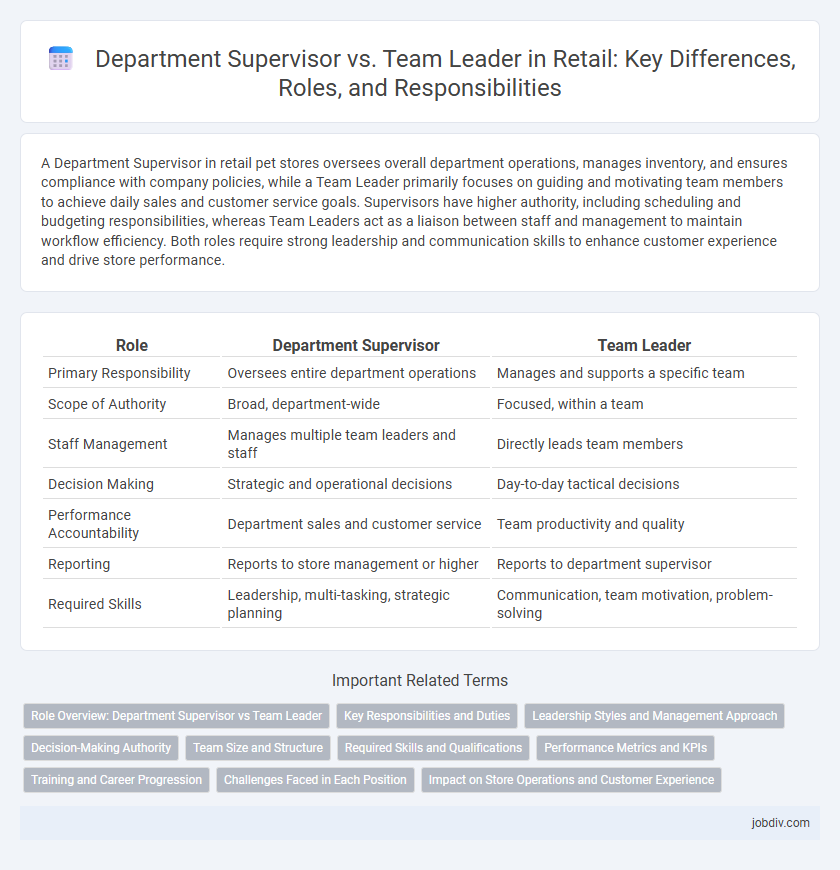A Department Supervisor in retail pet stores oversees overall department operations, manages inventory, and ensures compliance with company policies, while a Team Leader primarily focuses on guiding and motivating team members to achieve daily sales and customer service goals. Supervisors have higher authority, including scheduling and budgeting responsibilities, whereas Team Leaders act as a liaison between staff and management to maintain workflow efficiency. Both roles require strong leadership and communication skills to enhance customer experience and drive store performance.
Table of Comparison
| Role | Department Supervisor | Team Leader |
|---|---|---|
| Primary Responsibility | Oversees entire department operations | Manages and supports a specific team |
| Scope of Authority | Broad, department-wide | Focused, within a team |
| Staff Management | Manages multiple team leaders and staff | Directly leads team members |
| Decision Making | Strategic and operational decisions | Day-to-day tactical decisions |
| Performance Accountability | Department sales and customer service | Team productivity and quality |
| Reporting | Reports to store management or higher | Reports to department supervisor |
| Required Skills | Leadership, multi-tasking, strategic planning | Communication, team motivation, problem-solving |
Role Overview: Department Supervisor vs Team Leader
A Department Supervisor in retail manages overall store operations, ensuring inventory control, staff scheduling, and customer service standards are met. A Team Leader focuses on guiding a specific group, fostering teamwork, and directly supporting daily sales activities. Both roles aim to optimize employee performance and enhance the shopping experience but differ in scope and managerial responsibilities.
Key Responsibilities and Duties
Department Supervisors oversee daily operations in specific retail sections, managing inventory, staff scheduling, and customer service standards to ensure departmental efficiency. Team Leaders focus on motivating sales associates, coordinating team tasks, and maintaining communication between floor staff and management to drive sales performance. Both roles require leadership and organizational skills but emphasize operational management for Department Supervisors and people management for Team Leaders.
Leadership Styles and Management Approach
Department Supervisors typically employ a directive leadership style, focusing on task delegation, enforcing store policies, and maintaining operational efficiency within their department. Team Leaders emphasize a collaborative management approach, encouraging employee engagement, fostering teamwork, and facilitating communication to boost morale and productivity. Both roles require strong interpersonal skills, but Supervisors prioritize strategic oversight while Team Leaders concentrate on day-to-day team dynamics.
Decision-Making Authority
Department Supervisors hold higher decision-making authority compared to Team Leaders, responsible for overseeing departmental operations, managing budgets, and implementing store policies. Team Leaders focus on directing day-to-day tasks, ensuring team productivity, and providing frontline support, with limited autonomy in strategic decisions. This hierarchy ensures that Department Supervisors set goals and approve plans while Team Leaders execute tasks within those guidelines.
Team Size and Structure
In retail, a Department Supervisor typically manages a larger team, often overseeing multiple Team Leaders within their specific department, ensuring operational efficiency and staff coordination. Team Leaders are responsible for smaller groups, directly supervising frontline associates and handling day-to-day tasks to meet sales targets and customer service standards. The hierarchical structure places Department Supervisors at a higher level, focusing on strategic oversight, while Team Leaders manage detailed execution within their teams.
Required Skills and Qualifications
Department Supervisors require strong organizational skills, proficiency in inventory management, and experience in handling customer relations to ensure smooth store operations. Team Leaders need excellent communication abilities, motivational skills, and a solid understanding of daily sales targets to effectively guide frontline staff. Both roles demand leadership experience, problem-solving capabilities, and knowledge of retail software systems for optimal team performance.
Performance Metrics and KPIs
Department Supervisors typically oversee overall sales performance, inventory accuracy, and customer satisfaction scores, ensuring departments meet revenue targets and operational standards. Team Leaders focus on frontline employee productivity metrics, such as task completion rates, training effectiveness, and real-time problem resolution, driving daily operational efficiency. Key Performance Indicators (KPIs) for Supervisors include sales growth percentage, shrinkage rates, and customer feedback ratings, whereas Team Leaders are measured by employee engagement scores, task adherence, and average handling time.
Training and Career Progression
Department Supervisors typically oversee training programs, ensuring employees develop product knowledge and customer service skills critical for career advancement. Team Leaders focus on hands-on coaching, guiding daily tasks to improve team performance and prepare members for supervisory roles. Both positions play pivotal roles in employee development pathways, with supervisors managing broader career progression and team leaders fostering practical skill growth.
Challenges Faced in Each Position
Department Supervisors in retail often face challenges such as managing inventory accuracy, coordinating between multiple teams, and ensuring compliance with company policies, which requires strong organizational and leadership skills. Team Leaders typically encounter difficulties in motivating staff, resolving interpersonal conflicts, and meeting daily sales targets, demanding effective communication and problem-solving abilities. Both positions require adaptability to fluctuating customer demands and rapid response to operational issues to maintain store performance.
Impact on Store Operations and Customer Experience
A Department Supervisor directly manages daily merchandise presentation and inventory control, ensuring shelves remain stocked and promotional displays are executed, which significantly improves operational efficiency and product availability. In contrast, a Team Leader primarily motivates and guides frontline staff to deliver exceptional customer service, fostering a positive shopping environment that enhances customer satisfaction and loyalty. Both roles collaboratively impact store performance, but the Department Supervisor's focus on operational tasks complements the Team Leader's emphasis on team engagement and customer interactions.
Department Supervisor vs Team Leader Infographic

 jobdiv.com
jobdiv.com